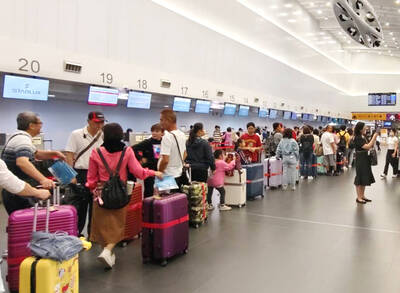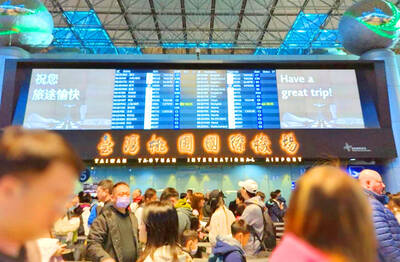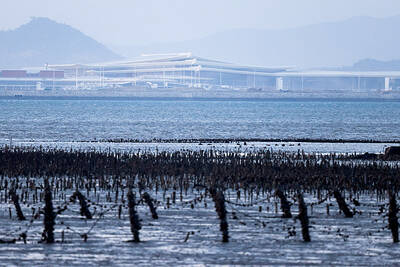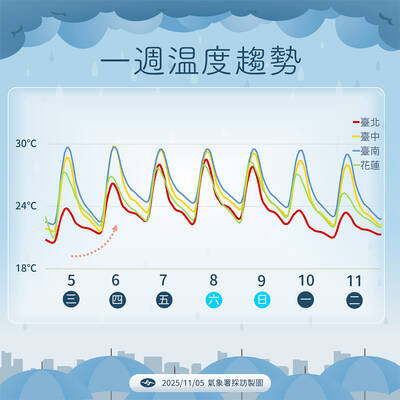A higher monthly minimum wage of NT$19,273 took effect yesterday, but the focus of the wage debate was already turning to the idea of a living wage.
The new minimum wage, approved by the Cabinet in September last year, represents a 1.2 percent increase from the previous level of NT$19,047. About 1.52 million Taiwanese and 290,000 foreign workers are expected to benefit from the increase.
As the minimum wage was being raised, the Ministry of Labor met with central and local government officials, experts and labor groups on Monday to discuss the living wage concept and agreed that cities and counties could set their own living wage standards.
A living wage is defined as the minimum amount a person must earn to reach a basic standard of living and is usually higher than the minimum wage, which is the minimum employers can legally pay their employees.
Labor ministry official Liu Chuan-min (劉傳名) said that the meeting looked at such questions as whether living wage standards would be enforced and whether they would lead to different pay for the same work in different parts of the nation.
“The setting of a living wage will not be binding for private companies, but it could have an effect on them,” Liu said, possibly by demanding that government contractors pay living wages or using it to push wages higher.
“Taipei has already set its own living wage standard that has benefited about 7,000 workers,” Liu said. “The labor ministry hopes that other local governments can follow suit, with the financial burden of the program dependent on each region’s finances.”
Some labor groups have raised concerns that different living wage standards across Taiwan would lead to a violation of the “equal pay for equal work” principle and cause regional imbalances in where people decide to work and a gap between the city and the countryside.
However, Liu said that the “equal pay for equal work” concept should not affect the living wage discussion.
“Equal pay for equal work involves not giving different pay for the same job, but it [the concept] should not be extended without limit to the setting of regional living wages,” he said.

Three Taiwanese airlines have prohibited passengers from packing Bluetooth earbuds and their charger cases in checked luggage. EVA Air and Uni Air said that Bluetooth earbuds and charger cases are categorized as portable electronic devices, which should be switched off if they are placed in checked luggage based on international aviation safety regulations. They must not be in standby or sleep mode. However, as charging would continue when earbuds are placed in the charger cases, which would contravene international aviation regulations, their cases must be carried as hand luggage, they said. Tigerair Taiwan said that earbud charger cases are equipped

Foreign travelers entering Taiwan on a short layover via Taiwan Taoyuan International Airport are receiving NT$600 gift vouchers from yesterday, the Tourism Administration said, adding that it hopes the incentive would boost tourism consumption at the airport. The program, which allows travelers holding non-Taiwan passports who enter the country during a layover of up to 24 hours to claim a voucher, aims to promote attractions at the airport, the agency said in a statement on Friday. To participate, travelers must sign up on the campaign Web site, the agency said. They can then present their passport and boarding pass for their connecting international

UNILATERAL MOVES: Officials have raised concerns that Beijing could try to exert economic control over Kinmen in a key development plan next year The Civil Aviation Administration (CAA) yesterday said that China has so far failed to provide any information about a new airport expected to open next year that is less than 10km from a Taiwanese airport, raising flight safety concerns. Xiamen Xiangan International Airport is only about 3km at its closest point from the islands in Kinmen County — the scene of on-off fighting during the Cold War — and construction work can be seen and heard clearly from the Taiwan side. In a written statement sent to Reuters, the CAA said that airports close to each other need detailed advanced

UNKNOWN TRAJECTORY: The storm could move in four possible directions, with the fourth option considered the most threatening to Taiwan, meteorologist Lin De-en said A soon-to-be-formed tropical storm east of the Philippines could begin affecting Taiwan on Wednesday next week, the Central Weather Administration (CWA) said yesterday. The storm, to be named Fung-wong (鳳凰), is forecast to approach Taiwan on Tuesday next week and could begin affecting the weather in Taiwan on Wednesday, CWA forecaster Huang En-hung (黃恩鴻) said, adding that its impact might be amplified by the combined effect with the northeast monsoon. As of 2pm yesterday, the system’s center was 2,800km southeast of Oluanbi (鵝鑾鼻). It was moving northwest at 18kph. Meteorologist Lin De-en (林得恩) on Facebook yesterday wrote that the would-be storm is surrounded by